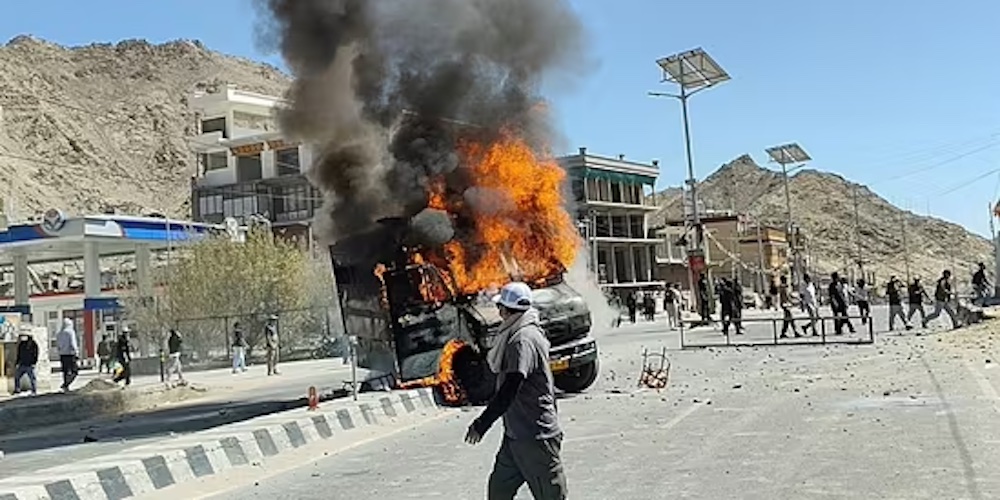A Manufactured Upheaval in Ladakh

The recent Ladakh violence, in which four were killed and over 60 injured, bore striking resemblance to Nepal’s Gen Z unrest
The much-touted Gen Z revolution in Nepal was orchestrated by the US deep state, on the same lines as movements in Bangladesh, Sri Lanka, Ukraine, and earlier in West Asia through the Arab Spring. The underlying objective of these mass mobilisations was regime change.
The single biggest enabling factor behind such flash-mob uprisings was social media, an arena over which the West enjoyed near-total monopoly. The success rate of these orchestrated mobilisations in effecting regime change was close to 80 percent. However, almost all of them ended in lasting disruption and instability. This was inevitable, because these movements were externally engineered rather than indigenous.
Strategic Objectives
Each regime change was pursued ruthlessly to fulfil strategic goals, with little regard for political or sociological consequences. In Ukraine, for example, regime change culminated in a bloody war that has left behind orphans, widows, and destitutes. The West’s objective was NATO expansion. That objective was not achieved, but Ukraine stands devastated.
In Bangladesh, the push for regime change sought to derail the China-Bangladesh Economic Corridor and roll back the China-Myanmar Economic Corridor. In Pakistan, Imran Khan was politically edged out by the military at the behest of the US deep state, primarily to obstruct the China-Pakistan Economic Corridor.
Creation of Key Communicators
Such regime changes require long-term investments: subverting institutions and grooming compromised individuals as “key communicators.” Figures like Asim Munir, Muhammad Yunus, Balen Shah, and Zelensky fit this category. They were cultivated over years by Western interests to play disruptive roles in their respective countries. Before their launch, conditions were manufactured, political fissures fabricated, social divisions widened, and tensions deliberately inflamed until violence spilled into the streets and governance became untenable. Nepal’s Gen Z movement followed this very script.
Foreign Tools, Foreign Methods
In Nepal, the Gen Z mobilisation, from protests to arson, lacked any nationalist component. That was inevitable, because its tools, methods, and objectives were foreign, not homegrown. Even the very name “Gen Z” was imposed by external handlers. A nationalist identity or theme would have carried no traction in international forums and could have affected foreign funding.
While the protesters ostensibly targeted the government, they also attacked national property and symbols: burning down the Parliament building, setting fire to the Supreme Court, attacking the historic Singh Durbar, even assaulting the Pashupatinath Temple, Nepal’s most revered symbol.
The result was not just the fall of a government but the trampling of a nation.
Similarly, Bangladesh’s so-called student uprisings carried imported names like “Monsoon Revolution” and “Gen Z Revolution.” In contrast, the 1971 liberation struggle in East Pakistan had indigenous themes, “Mukti Yodha” and “Sangram”, which gave it lasting legitimacy. Today’s foreign-scripted movements, however, often produce fundamentalist or jihadi forces. Under the Yunus regime, even the long-marginalised Jamiat-e-Islami has regained influence.
Typically, such Western-backed movements exploit gullible youth alongside criminal elements, making arson, violence, and mayhem inevitable. In Bangladesh, Gen Z mobilisation shredded the country’s secular, democratic, and demographic fabric.

Ladakh: The Next Soft Spot
After Nepal, there were strong indications that a “Gen Z-style” mobilisation might be attempted in India. While earlier attempts in the hinterland had failed, Ladakh was identified as a soft target due to its geostrategic sensitivities: it borders Pakistan in the west and China in the east.
With its small population base of around three lakhs and limited revenue capacity, Ladakh is heavily dependent on the central government. Yet agitators demanded full statehood, a demand externally encouraged to provoke a heavy-handed response from New Delhi. This mobilisation triggered unprecedented violence in Ladakh, greater even than that witnessed after Article 370’s abrogation.
The government’s decision to hive off Ladakh as a Union Territory was made in deference to its strategic and cultural uniqueness. But external actors soon catapulted Sonam Wangchuk into prominence to overshadow this achievement.
The Case of Sonam Wangchuk
Sonam Wangchuk’s father was a cabinet minister in the Abdullah government, but neither he nor his son ever demanded UT status at that time. Wangchuk was first promoted in the West as an “innovator” and “scientist,” showered with awards from organisations like the CIA-linked Rockefeller and Ford Foundations. This culminated in the Magsaysay Award, long seen as a tool for advancing the US agenda. Several Indian awardees, including Ravish Kumar, Arvind Kejriwal, and Aruna Roy, followed similar trajectories.
Wangchuk’s transformation from innovator to political activist came only after such recognition. His links became clearer when he met Muhammad Yunus and later travelled to Islamabad for the “Breathe Pakistan” conference. In 2023, he staged a hunger strike to block Khardung La Pass, vital for troop and logistic movement in Ladakh and Siachen. He even hinted that Ladakhis might not side with India in case of a Chinese invasion.
His demand for Sixth Schedule status raises suspicions of an attempt to block the establishment of a microchip industry in Ladakh, which possesses ultra-pure silica sand, critical for semiconductor manufacturing. Sixth Schedule powers would allow local bodies to control industrial land use, potentially stymieing national strategic projects.
The Nepal Script in Ladakh
The recent Ladakh violence, in which four were killed and over 60 injured, bore striking resemblance to Nepal’s Gen Z unrest. Wangchuk himself invoked the movements in Bangladesh and Nepal to incite protesters. Reports suggest Nepalese elements and youth from Doda (Kashmir) infiltrated the mobs, further fuelling the violence.
In Nepal, even schoolchildren were dragged into the agitation, sent to protests in uniform, with school bags on their backs. Can a ten-year-old truly make an informed political choice? Fed on such negativity, these children will grow into cynical adults, of little use to their families or nation. The Gen Z conspirators have stolen their innocence.
Conclusion
Whether in the form of Yunus in Bangladesh, Balen Shah in Nepal, or Sonam Wangchuk in Ladakh, these actors are guilty of political manipulation that preys on the young. Given the demographic surge in South Asia, it is only a matter of time before a new “Gen Z” emerges, once again baying for blood, once again destabilising nations at the behest of foreign powers.
(Colonel RSN Singh is a former Research and Analysis Wing officer and also a former Indian Army officer. He has written several books and has given talks on geopolitical defense and strategic issues, particularly from an Indian perspective)


